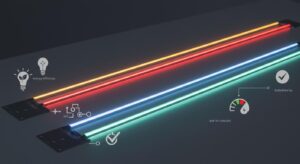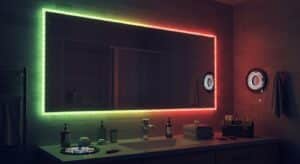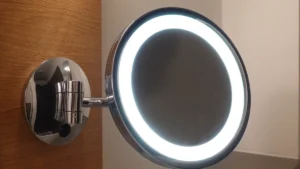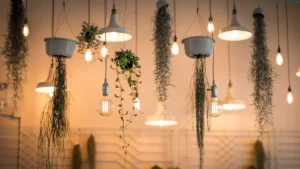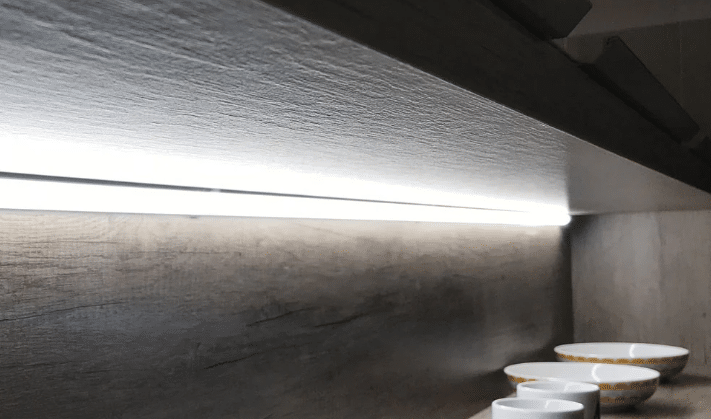
Ultra bright LED strip lights are bendable lights that shine very brightly and save energy. They use energy well and can be used in homes, businesses, and cars.
The world market for LED strip lights was worth $2.3 billion in 2022. It is expected to grow to $4.5 billion by 2030 because people want eco-friendly lighting.
Key Takeaways
Ultra bright LED strip lights use less energy and cut electricity bills. They use up to 44% less power than old fluorescent lights.
These lights are very bright, giving at least 450 lumens per foot. They work well in homes, shops, and outdoor areas.
LED strip lights last a long time, between 50,000 to 100,000 hours. This means you replace them less often and save on maintenance.
Benefits of ultra bright LED strip lights
Energy efficiency and cost savings
Ultra bright LED strip lights use much less energy. They need up to 44% less power than old fluorescent lights. This makes them cheaper to run and better for the planet. Switching to these lights lowers your electricity costs. They also help the environment by using less energy. Their smart design gives bright light without wasting power. These lights work well in homes and businesses.
High brightness and light output
LED strip lights are very bright. Their brightness is measured in lumens. The number of chips and power used affects how bright they are. More chips mean stronger light, great for bright spaces. Use them to light up artwork, shops, or work areas. They give steady and focused light for any task.
Long lifespan and durability
LED strip lights last a long time. They can work for 50,000 to 100,000 hours. This is much longer than old bulbs. Instead of suddenly breaking, they slowly get dimmer. Even after many hours, they still work well. This saves you money and time on replacements. They are reliable and built to last.
Lifespan Rating | Meaning |
|---|---|
L70 | Keeps 70% brightness after its lifespan |
L80 | Keeps 80% brightness after its lifespan |
L90 | Keeps 90% brightness after its lifespan |
Versatility in design and application
LED strip lights can be used in many ways. At home, they make rooms look better. Put them under cabinets, behind furniture, or in ceiling corners. Shops and restaurants use them to create nice displays and cosy spaces. You can cut and shape them to fit any area. This makes them perfect for custom lighting designs.
“LED strips are great for modern designs because they are flexible. You can cut and shape them to fit any space, making them fully customisable.
Applications of ultra bright LED strip lights
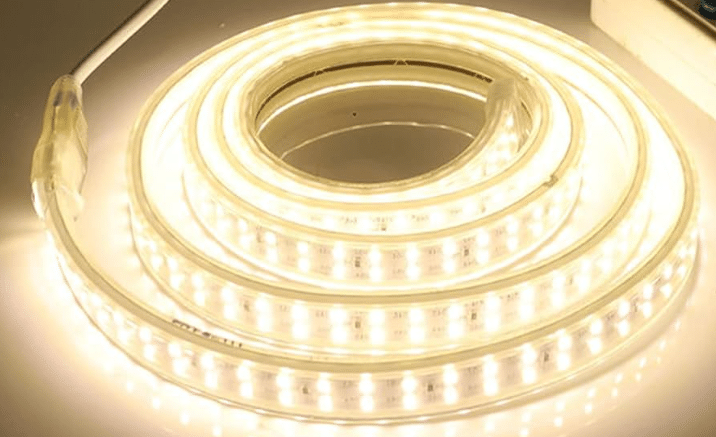
Residential lighting solutions
Ultra bright LED strips make homes look better and brighter. Put them under kitchen cabinets for better lighting while cooking. Use them to show off features like crown moulding. In bedrooms, they create a warm feel behind headboards or ceilings. You can bend and shape them to match your style. This makes your home both useful and stylish.
Commercial and retail lighting
Shops and businesses use LED strips for good lighting. Stores light up products to make shopping more fun. Cafes and restaurants use them to set the mood. They can create a cosy or modern look. A garage switched old lights for LEDs, saving energy and space. This change made the area brighter and better.
Outdoor and landscape lighting
LED strips work well outside for paths, gardens, and patios. They make outdoor spaces safe and pretty. The market for outdoor LED strips is growing fast. It was worth USD 2.5 billion in 2023 and may reach USD 6.3 billion by 2032. Governments push for energy-saving lights, boosting demand.
Automotive and industrial uses
Cars use LED strips for style and better lighting inside. They also light up under the car or for custom designs. Factories use them to make workspaces safer and brighter. These lights last long and are tough, saving money in hard-working places.
Features to think about in LED strip lights
Brightness levels and lumens
Brightness is important when picking LED strip lights. It is measured in lumens, with higher lumens meaning brighter light. The number of LED chips on the strip affects brightness. More LEDs per foot give better and stronger light.
Different uses need different brightness levels:
Accent lighting: 150-350 lumens per foot
Close task lighting: 275-450 lumens per foot
Replacing fluorescent tubes: 500-950 lumens per foot
Colour temperature choices
Colour temperature changes how a space feels and works. It is measured in Kelvin (K), from warm white (2700K) to cool white (6500K). Warm tones feel cosy, while cool tones suit work areas. Poor-quality strips or voltage drops can change the colour. Choose good-quality strips for steady lighting.
Waterproofing and strength
Waterproof LED strips are needed for wet or outdoor areas. Check the IP rating to see how water and dust-resistant they are. IP65 strips handle splashes, while IP68 strips can go underwater. Strong strips with good coatings last longer and work better.
Power use and compatibility
LED strips save energy and use less power than old lights. A good strip uses at least 4 watts per foot. They run on low-voltage DC power, usually 12V, making them safe. Many strips now have smart controls. You can change brightness and colour using apps, which is very handy.
Feature | Description |
|---|---|
Energy Use | LED strips use much less power than older lights. |
Long Life | They last longer, so you replace them less often. |
Compatibility | They work well in homes, shops, and other places. |
Smart Control | Apps let you control brightness and colour easily. |
Heat Control | Good heat management keeps the lights working well longer. |
Choosing the right LED strip lights
Knowing your lighting needs
Think about what lighting you need before buying LED strips. Different places need different brightness and uses. Kitchens and living rooms often need task or accent lights. Outdoor areas may need waterproof strips to last longer. A study shows offices need 50-75 foot-candles for work. Living rooms only need 10-20 foot-candles. Pick the right type for the best results and energy savings.
Picking the right brightness
Choose the right brightness for your LED strips. Brightness is measured in lumens and depends on the use. Accent lighting needs 150-350 lumens per foot. Task lighting might need up to 450 lumens per foot. Commercial spaces need brighter lights for better visibility and lower costs. More LED chips per metre give stronger and even light.
Installation tips
Installing LED strips properly helps them last longer. Clean and dry the surface before sticking the strips. Use the adhesive backing and follow the maker’s instructions. Make sure the power connections are secure. Follow safety rules like the RoHS and Low Voltage Directives. These steps make installation easier and safer.
Balancing cost and quality
Find a balance between price and quality. Good LED strips have strong copper wiring and better coatings. These features make them brighter and last longer. Trusted brands offer better performance and durability. Cheaper options may save money now but cost more later. Quality strips need fewer repairs and replacements, saving money over time.
Installation tips for LED strip lights
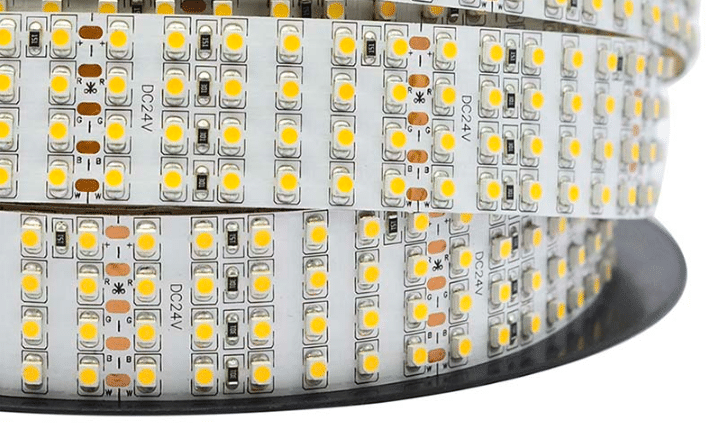
Tools and materials needed
Get all tools and materials ready before starting. You will need:
LED strip lights
A matching power supply
Alcohol wipes or mild cleaner
A dry cloth
Scissors or a utility knife (to cut strips)
Connector cables or soldering tools (to join strips)
Adhesive tape or mounting clips (to secure strips)
A multimeter (to check connections)
Having everything prepared saves time and avoids delays during setup.
Preparing the surface and planning
Prepare the surface properly for a strong and lasting setup. Follow these steps:
Clean the surface with alcohol wipes to remove dirt.
Focus on greasy or dusty spots for better sticking.
Avoid using harsh cleaners that leave residue.
Dry the surface with a clean cloth to remove moisture.
Let the surface air dry, especially in humid weather.
Check for any leftover moisture before continuing.
After cleaning, plan where to place the LED strips. Measure the area and mark positions. This ensures a good fit and fewer changes later.
Connecting and fixing the strips
Follow these steps to connect and secure the strips:
Step | What to Do |
|---|---|
1 | Clean the surface for better sticking. |
2 | Cut the LED strip to the needed length at marked spots. |
3 | Attach the power supply that matches the strip’s needs. |
4 | Stick the strip onto the surface, pressing firmly to secure it. |
5 | Join extra strips using connectors or soldering tools if required. |
6 | Test the lights to check they work properly. |
7 | Adjust the strips for better alignment or trim if needed. |
Make sure all connections are tight and in the right place. Use mounting clips or tape for extra support if necessary.
Testing and fixing problems
Test your LED strips after setting them up to ensure they work. If there are problems, try these steps:
Check all connections between strips, connectors, and the power supply.
Make sure the power supply matches the strip’s voltage and current needs.
Use a multimeter to check if the power supply works.
Look for damage to the strips or loose wires.
Restart the system if the lights act strangely.
Check for short circuits or other items causing issues.
Fixing these common problems will help your LED strips work well and last longer.
Maintenance and care for LED strip lights
Cleaning and upkeep
Cleaning keeps LED strip lights bright and working well. Dust and dirt can block light and make them dim. Use a soft cloth or duster to clean gently. Do not use strong chemicals or too much water, as they can harm the lights. For outdoor or waterproof strips, check the coating stays undamaged during cleaning.
Avoid bending the strips too much, as it can break the wires inside. If changes are needed, add waterproofing to keep them strong. Cleaning often helps the lights work better and last longer.
Fixing common issues
Sometimes LED strip lights may flicker, dim, or stop working. First, check all connections to ensure they are tight and not broken. Make sure the power supply matches the strip’s voltage and current needs. A multimeter can help find power problems.
If part of the strip stops lighting, look for damage. Replace the broken part quickly to avoid more problems. Use surge protectors to stop voltage spikes from damaging the lights. Regular checks help find and fix problems early.
Ensuring long-term performance
To keep LED strip lights working well, follow these tips:
Use the right power supply to stop overheating.
Add surge protectors to handle voltage changes.
Keep the power supply cool and clean with good airflow.
Clean the strips often to stop dust from building up.
Check for damage and replace bad parts when needed.
Use timers to reduce turning the lights on and off too much.
These steps help your lights stay bright and last for many years.
Ultra bright LED strip lights are useful in many ways:
Art and Display: Show off art and exhibits clearly.
Retail and Commercial: Make products stand out and spaces welcoming.
Architectural and Interior Design: Add style and highlight features.
Outdoor Applications: Light up gardens and paths beautifully.
To pick the right lights, follow these steps:
Check how bright the lights need to be.
Decide if you want single or multicolour lights.
Pick flexible strips for curved areas.
Make sure the strips can be shaped for your project.
Match the power supply to the strip’s voltage.
Discover new ideas and improve your spaces with LED strip lights.
FAQ
What brightness is best for LED strips in a living room?
Pick LED strips with 10-20 foot-candles or 150-350 lumens. This gives a warm and comfortable feel.
Can LED strip lights be trimmed to fit spaces?
Yes, you can trim LED strips at marked spots. Cut carefully and reconnect properly to keep them working.
How should waterproof LED strips be cared for?
Wipe waterproof LED strips with a soft cloth gently. Do not use strong cleaners. Check the coating often for any damage to keep them lasting longer.
Tip: Always look at the IP rating before using LED strips in wet or outdoor places.
See Also
Comparing Bright LED Strips For Various Uses And Needs
Adjustable COB LED Strips For Flexible Lighting Solutions
Selecting The Perfect LED Strip Lights For Linear Illumination
